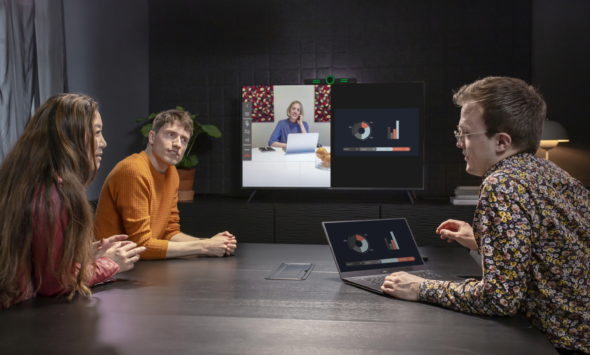
The global pandemic has inspired a tidal wave of home working innovations and the impact on the conferencing market has been huge. But what comes next? And how can resellers continue to maximise sales momentum in an age where video, and not just audio, is the new king of conferencing?
Ed House, sales and commercial director, Nuvias UC said video communication is becoming the “new norm” after emerging from a “nice to have” day-to-day tool. “When everyone was forced to work from home, video usage accelerated and to many businesses it’s now essential. This is evident when you look at the statistics in the growth of leading eco-system providers.”
He revealed, “Pre Covid-19, many of our partners were still focused on hosted voice solutions with no video and no instant messaging functions. Due to increased demand, they moved away from their traditional offering. Not only were they adopting video themselves but they were also open to adding video to their own service/portfolio.
“Now that everyone has had a taste of flexible working and it’s been proven that you can remain productive while working from home, removing the stigma attached to home working – providing you have the right communication tools – I think it will become the new norm to have video communications as part of your business strategy.”
Cameras replace suits
Jeff May, UK sales director at manufacturer Konftel agreed the world has changed. “In the past we always wanted to get dressed up and make our best impression face-to-face but that’s not possible anymore. Cameras have replaced suits but we’ve still got to look our best and sound our best.
“The pandemic has changed everything and it won’t go back to the way it was before. It used to be a suit or a handbag or a watch that impressed in a physical meeting room, now it’s the sharpness and clarity of a video feed. And if you’re sharp and clear, your presentation or negotiation in that meeting is 100 per cent more impactful. If you’re not able to be heard or seen properly, then your contribution is undermined. And we’re way past the days when we can get away with blaming that on working from home.”
He added, “Simple, easy to use, dual purpose, powerful and portable solutions – for the home as well as office – are the way forward. Konftel offers something for everybody, from a home office to the biggest boardroom. Hybrid working is the way forward.”
For Simon Hughes, brand manager for Konftel at Trust Distribution, the pandemic has seen the conferencing market soar. “Video collaboration solutions have become the perfect solution allowing communication to continue just like actual meetings. Organisations require good quality audio and video solutions without being overly technical and free of interruptions. Trust has witnessed increased demand for webcams and Konftel’s easy to use One Cable Connection Hub.”
Justin Hamilton-Martin, sales director UK, Enreach for Service Providers, feels that as video has accelerated, audio conferencing has ‘all but collapsed’ except to offer another route into a video call. He explained “What users want from conferencing is ease-of-use, especially the younger generation who as true digital natives, expect it to ‘just work’. For instance, WebRTC — where conferencing can be accessed via any web browser with no need to download an app — is proving appealing to all generations, young or mature.”

What opportunities remain?
May feels the industry is only at the tip of the iceberg. “There are huge reseller opportunities out there and in many ways we are only at the start of the journey. The pandemic triggered a tidal way of purchasing. It was literally just buy what was available and in some cases it was a bit of a panic, without any spec or budget allocations due to supply shortages. Now the goalposts have moved and it’s about investing in the right technology for longer term collaboration, across the home and office. In many cases businesses need to raise their game. Volume sales are on the horizon with properly equipped offices and also higher quality remote working tools.”
House at Nuvias UC said, during the first lockdown, people were just trying to get by with what they had at home such as their personal headphones or AirPods.
“However, this isn’t sustainable for people who want to implement a full-time remote working plan. Users need a comfortable headset that they can wear all day, which will eliminate the background noise and minimise distractions. To truly feel like you’re having a face-to-face conversation, the audio and video needs to be high quality, so users will continue to seek best-of-breed peripherals.
“If users start to return to the office, there will be a consolidation opportunity. Many workplaces would’ve given their employees either vouchers or money to get themselves equipped. When they come back to work, IT managers need a way to manage these devices.”
Hughes highlighted, “I think the pandemic initially took most people by surprise resulting in businesses needing to set up their teams and enable working from home quickly. This surge in sales meant that supplies were in short supply and people rushed in to just find whatever solution they could. Now we have all adjusted, and people have become so much more aware of the options available, they are looking for better quality, more effect and long-term conferencing that is adaptable to home or office.
“Although we have seen the market adapt and the use of web-based video conferencing significantly increase, we are continually seeing demand for physical conferencing kit to integrate as the Konftel range offers stability during the call which some web-based conferencing brands struggle with.”
There is still a lot of room for differentiation according to Hamilton-Martin, who advised, “Look for solutions that offer granular options, such as different packages for two, ten, fifty or more users. The channel should be able to pick and choose the components they need within a conferencing service, as well as give users the features they need, not those for which they do not want to pay. We need to get away from a one-size-fits-all mentality, but simultaneously, make differentiation easy”.
Simplicity and sustainability
House thinks there’s definitely a focus on making solutions easier for everyone to use, rather than people relying on their IT manager to help them set-up a meeting or install a new device.
“For example, the introduction of one-touch dial to connect to a call from a device in a meeting room , integration with the outlook calendar for scheduling and the simple plug ‘n’ play hardware attachment. These capabilities have evolved to maximise end-user adoption. Likewise, for those working from home, if you have an internet connection then WEB RTC makes it easy to access scheduled meetings by the click of a hyperlink, even if you’re only using the standardised webcam and built-in laptop mic.”
Hughes, from Trust Distribution, feels that once users adapt to anything new, they very quickly become more demanding. “They want more features but with increased ease of use along with good quality visual and audio. Over the past year we have seen the Konftel product range evolve and expand to meet demand and there is so much more to come. For example, they have just launched their new 1080p Cam10 USB video camera which can be used as a standalone device using the built-in microphones or integrated with Konftel USB audio conferencing units.”
 Hamilton-Martin at Enreach for Service Providers (pictured right), noted, “In our personal lives, we have become accustomed to intuitive user experiences, and that needs to extend to the workplace.
Hamilton-Martin at Enreach for Service Providers (pictured right), noted, “In our personal lives, we have become accustomed to intuitive user experiences, and that needs to extend to the workplace.
“We fully expect to see more customer-facing video conferencing, especially with the growth of cloud-based ‘casual’ contact centre functionality. Anyone customer-facing is in essence in a contact centre function and it’s vital to think about the entire journey, what inbound and outbound channels are being used (beyond voice, and email), especially as many people prefer to communicate via chat tools of any type versus using audio.”
May endorsed the view that there’s now more focus on the user experience, but feels there’s more work to be done. “Everybody is more knowledgeable now through using video services, and more demanding but from a software point of view there are intricacies that need to be learned. Simplicity is key. A remote worker for example just wants simple plug-and-play USB hardware which is compatible with lots of different software variants. For us it has to be universal, simple to set up and simple to use.
“When people do return to the office they need the same flexibility just on a bigger scale. They don’t want to be confused by a big screen with a separate audio device and lots of unfamiliar cables. That’s where our One Cable Connection hub really shines which makes it as simple as using USB.”
Quality counts
 House, from Nuvias UC (pictured right), believes clear video relies on good internet bandwidth, which is why some lean on a managed service provider to better optimise their calls. “You only get out what you put in. So, if you don’t have a high-quality webcam or mic, you’re always going to be displaying a low-quality image to the rest of the participants in the call - irrelevant of whether you have a good internet connection or not. Admittedly, the laptops you can buy today with the built-in equipment are improving on quality but there’s no flexibility on camera position or advanced features such as framing, to draw attention to you as you speak.”
House, from Nuvias UC (pictured right), believes clear video relies on good internet bandwidth, which is why some lean on a managed service provider to better optimise their calls. “You only get out what you put in. So, if you don’t have a high-quality webcam or mic, you’re always going to be displaying a low-quality image to the rest of the participants in the call - irrelevant of whether you have a good internet connection or not. Admittedly, the laptops you can buy today with the built-in equipment are improving on quality but there’s no flexibility on camera position or advanced features such as framing, to draw attention to you as you speak.”
All-in-one video bars with built in microphones and noise blocking can be a cost-effective way to tick all the boxes, he emphasised.
Konftel’s May said 4K is becoming the de facto standard but it’s not just as simple as just buying a high spec camera. “There’s bandwidth to consider and also the associated equipment. The monitor might not output in 4K or a laptop might not pass through the signal. HDMI cabling is vital too. Video is only as good as the weakest part of the chain. It’s about making sure all the pieces of the puzzle fit together in the right way.”
Trust Distribution’s Hughes pointed out that although the current conferencing equipment is already of a high standard – such as Konftel’s Cam20 with a 4K Ultra PTZ HD Camera - as a whole there needs to be improvements with the equipment and services that work alongside conferencing, such as broadband speeds and monitor resolutions.
Smoother integration
With so many different platforms available, May feels, “Everything needs to be open standard so people can communicate on any platform, any device, anywhere. I expect all the major platforms will develop new services which must be transparent, not proprietary. There are four main players that will dictate the market. Joint collaborations would be fantastic.
“From our point of view it’s about being able to provide universal hardware that is flexible, easy to set-up and very high quality so whatever an end user requires, even using a mobile phone, they have that option.”
Nuvias UC’s House said that, although many were anticipating a ‘Teams takeover’ pre-pandemic, it hasn’t been fast tracked until recently. “However, I still think some businesses see it as an internal tool. I’m not sure whether this is because they just utilise the free licencing within their O365 package and haven’t extended their licences to reach externally. As more users pick up teams to communicate outside of their own business, they – and the people who they would like to reach – will need to find a way to adapt their existing solutions to communicate via Teams.”
Hughes at Trust Distribution thinks selecting futureproof easy set-up products – that are flexible enough to connect video and audio to any communication platform – and can be used either in the home office or workplace – is crucial.
Whilst Hamilton-Martin pointed out, “If thinking about conferencing externally, then integration with a customer relationship (CRM) system should be high on the list. This can become central point for all customer engagement channels, both inbound and outbound, across voice, email, chat, SMS, social media and various apps – rather than them being siloed. This more holistic approach supports a more consistent customer journey, better information tracking, reporting and analytics.”
Game playing
Adding fun and an element of games seems set to grow in popularity. For House at Nuvias UC it’s a great way to boost employee engagement. “As a business – even before Covid – we went on an adoption path. What we wanted was more people utilising video and for us it was a cost-saving exercise, but we turned it into a competition. We wanted to see who could convert their time travelling into productive meetings. Our employees received points for their minutes, while we saved on travel expenses!
“We’re not saying that everything should be done over video because we know some conversations are easier had face-to-face, plus, we can’t wait to socialise with our friends from the industry again. However, it’s just about getting into a new mindset and realising the benefits of adapting to change.
“Now that everyone is more used to video, I think it encourages us to dial out more often, rather than waiting for that next meeting – virtual quizzes and bingo nights are a great way to raise employee engagement too!
Hamilton-Martin, said introducing more fun into communications and collaboration in general is certainly an area in which they are interested.
“After all, with more people living in a digital workplace, anything that lightens the day has to be a good thing. Giving people simple video games while they are waiting for a meeting to start is one example that can work well to lighten the mood if the host is running late!”
